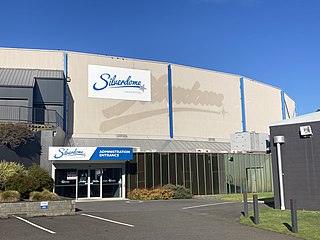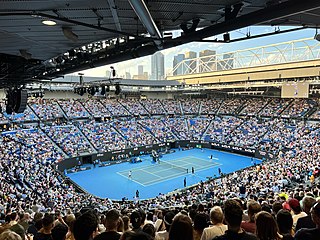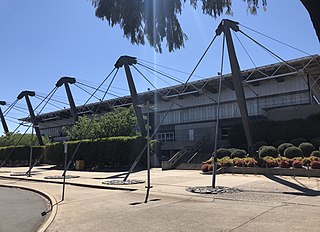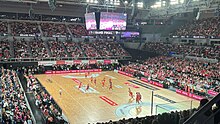
Melbourne Park is a sports venue in the Melbourne Sports and Entertainment Precinct in Melbourne, Victoria, Australia. Since 1988, Australia's bicentenary, Melbourne Park has been home of the Australian Open Grand Slam tennis tournament played annually in January. The park has multiple venues where the Australian Open matches take place. Rod Laver Arena is the largest venue with a capacity of 15,000, while John Cain Arena seats 10,500 and Margaret Court Arena 7,500. The three venues feature retractable roofs, allowing events to be played indoors or outdoors. Besides, there is the Show Court 3 and 1573 Arena which both have a 3,000 seating capacity, and the new 5000-seat Kia Arena. In total there are 35 outdoor Greenset tennis courts at Melbourne Park.

The Silverdome, Australia's first indoor velodrome, is an indoor sporting and entertainment venue located in Launceston, Tasmania built in 1984. The capacity of the venue is 5,000.

Newcastle Entertainment Centre is a multi-purpose Australian arena within the Newcastle Showgrounds. It was opened in 1992.

The Melbourne Sports and Entertainment Precinct is a series of sports stadiums and venues, located in Melbourne, Victoria, in Australia. The precinct is situated around 3 km east of the Melbourne central business district, located in suburbs of Melbourne and Jolimont, near East Melbourne and Richmond.

Rod Laver Arena is a multipurpose arena located within Melbourne Park, in Melbourne, Victoria, Australia. The arena is the main venue for the Australian Open, the first Grand Slam tennis tournament of the calendar year.

Sydney Entertainment Centre, later known as Qantas Credit Union Arena, was a multi-purpose arena located in Haymarket, Sydney, Australia. It opened in May 1983, to replace Sydney Stadium, which had been demolished in 1970 to make way for the Eastern Suburbs railway line. The centre was owned by the Sydney Harbour Foreshore Authority, which administered the neighbouring Darling Harbour area, and managed under a lease.
The Brisbane Entertainment Centre is a multi-purpose indoor arena located in the Brisbane suburb of Boondall, Queensland, Australia. The centre is managed by ASM Global. The centre also houses a sporting complex and small function rooms which are available to hire for wedding reception and business functions.

The Derwent Entertainment Centre (DEC), known commercially since 2021 as MyState Bank Arena, is Tasmania's largest indoor arena, serving as Hobart's primary venue for large indoor functions and events. Commissioned by the Tasmanian Government and the Glenorchy City Council, the DEC served as the home arena for the Hobart Devils in the NBL from 1989 until 1996, when the team's licence was revoked. Subsequently, between 1997 and 1998 ownership was transferred entirely to the City of Glenorchy, where it became a financial burden, incurring significant maintenance expenses for Glenorchy taxpayers while seeing limited use. As the largest indoor venue in Tasmania, the DEC has attracted international touring acts including Bob Dylan, Carole King, Kylie Minogue, James Brown, Leonard Cohen, Tina Turner, Blondie and The Beach Boys.

The Sydney SuperDome is a multipurpose arena located in Sydney Olympic Park suburb of Sydney, New South Wales, Australia. It was completed in 1999 as part of the facilities for the 2000 Summer Olympics.

Margaret Court Arena is a multi-purpose sports and entertainment venue located in Melbourne Park in Melbourne, Victoria, Australia. The arena, which was built in 1987 and redeveloped in the mid-2010s, has a capacity of 7,500.

Adelaide Arena is a multipurpose indoor sports stadium located in Findon, an inner western suburb of Adelaide, South Australia.

Parkville Stadium, previously known as the State Netball Hockey Centre is a multipurpose sporting facility located in Melbourne, Australia. It is the administrative headquarters for both Netball Victoria and Hockey Victoria and features two outdoor hockey fields and eleven indoor netball courts, with the main hockey field capable of seating up to 8,000 and the main Netball court seating up to 3,050 spectators. National Basketball League club Melbourne United played home matches at the venue in the past, as well as Super Netball team Melbourne Vixens, though both clubs have shifted home matches to larger-capacity arenas. Hockey Club Melbourne of the Hockey One league play home games on the main hockey pitch.

AIS Arena is a multi-purpose arena in Canberra, Australia. Its capacity is 5,200 and it was built in 1980. The arena was opened by the Prime Minister of Australia, Malcolm Fraser, on 26 January 1981 and was originally named the National Indoor Sports Centre and was the inaugural home of the Australian Institute of Sport.
The Melbourne Sports and Entertainment Centre is a sports administration and training facility located in the Melbourne Sports and Entertainment Precinct in Melbourne, Australia. The facility opened in 1956 as an aquatic centre for the 1956 Olympic Games. In 1983, the Olympic-sized pool was replaced with a parquetry floor and the facility became Melbourne's home of numerous basketball events until 1998, most notably as the home venue for several National Basketball League teams including the North Melbourne Giants and Melbourne Tigers. The venue served as Melbourne's primary indoor concert arena from 1984 to 1988, until completion of the Rod Laver Arena.

The State Sports Centre is a multi-use indoor arena in Sydney, New South Wales, Australia and was opened in November 1984. With a total of 3,854 fixed and retractable seats the main arena is a focal point of the Sydney Olympic Park Sports Centre. An additional 1,152 portable seats can be accommodated on the floor level to bring seated capacity to 5,006.

The Sydney Olympic Park Tennis Centre is a tennis and multi-purpose sports facility in the Sydney Olympic Park suburb of Sydney, New South Wales, Australia. The centre was built in 1999 and hosted the tennis events for the 2000 Summer Olympics. The venue hosted the Sydney International tournament from 2000 to 2019, the Sydney Tennis Classic in 2022, the ATP Cup in 2020 and 2022, and the United Cup since 2023. The main stadium in the centre is the Ken Rosewall Arena, which has a seating capacity of 10,500, and is capable of hosting multiple sports, including tennis and netball.

Perth Arena is an entertainment and sporting arena in the city centre of Perth, Western Australia, used mostly for basketball matches. It is located on Wellington Street near the site of the former Perth Entertainment Centre, and was officially opened on 10 November 2012. Perth Arena is the first stage of the Perth City Link, a 13.5-hectare (33-acre) major urban renewal and redevelopment project which involves the sinking of the Fremantle railway line to link the Perth central business district directly with Northbridge.
Bendigo Stadium is an Australian sports and entertainment centre in Bendigo, Victoria. The stadium is home to the Bendigo Braves (NBL1) and Bendigo Spirit (WNBL). It hosted basketball matches during the 2006 Commonwealth Games and will host netball during the 2026 Commonwealth Games. The stadium's facilities include ten indoor sports courts, major exhibition and function areas, a licensed clubroom and associated administration facilities.

The Queensland State Netball Centre, also known commercially as Nissan Arena, is a multi-purpose facility located in the southern Brisbane suburb of Nathan. The centre features a 5,000 seat indoor arena that is the home court of Super Netball team the Queensland Firebirds, as well as National Basketball League club the Brisbane Bullets. It is the administrative headquarters of Netball Queensland and provides training facilities for elite-level and community-based netball clubs in Queensland.

The Cairns Pop-Up Arena was a sports arena in Cairns, Queensland, Australia. The arena was the temporary host of the Cairns Taipans and the South East Melbourne Phoenix, whilst the Cairns Convention Centre underwent a redevelopment.




















